University Psychology Essay: Self-Concept, Self-Esteem, and Influences
VerifiedAdded on 2020/04/15
|8
|2193
|277
Essay
AI Summary
This essay delves into the concepts of self-concept and self-esteem within the realm of social psychology. It begins by defining self-concept as an individual's perception of themselves, encompassing beliefs about their attributes, and self-esteem as the evaluation of one's own worth. The essay outlines the similarities and differences between these two constructs, emphasizing how self-esteem is a crucial component of self-concept. It then explores empirical evidence, identifying gender as a factor that can influence self-concept, with studies indicating changes in self-esteem during adolescence, and the impact of societal pressures on self-esteem. The work references key researchers and studies to support its arguments, concluding that while the two concepts are closely related, the inclusion of feelings is the main differentiator. The essay provides a comprehensive overview of these psychological concepts and their interplay.
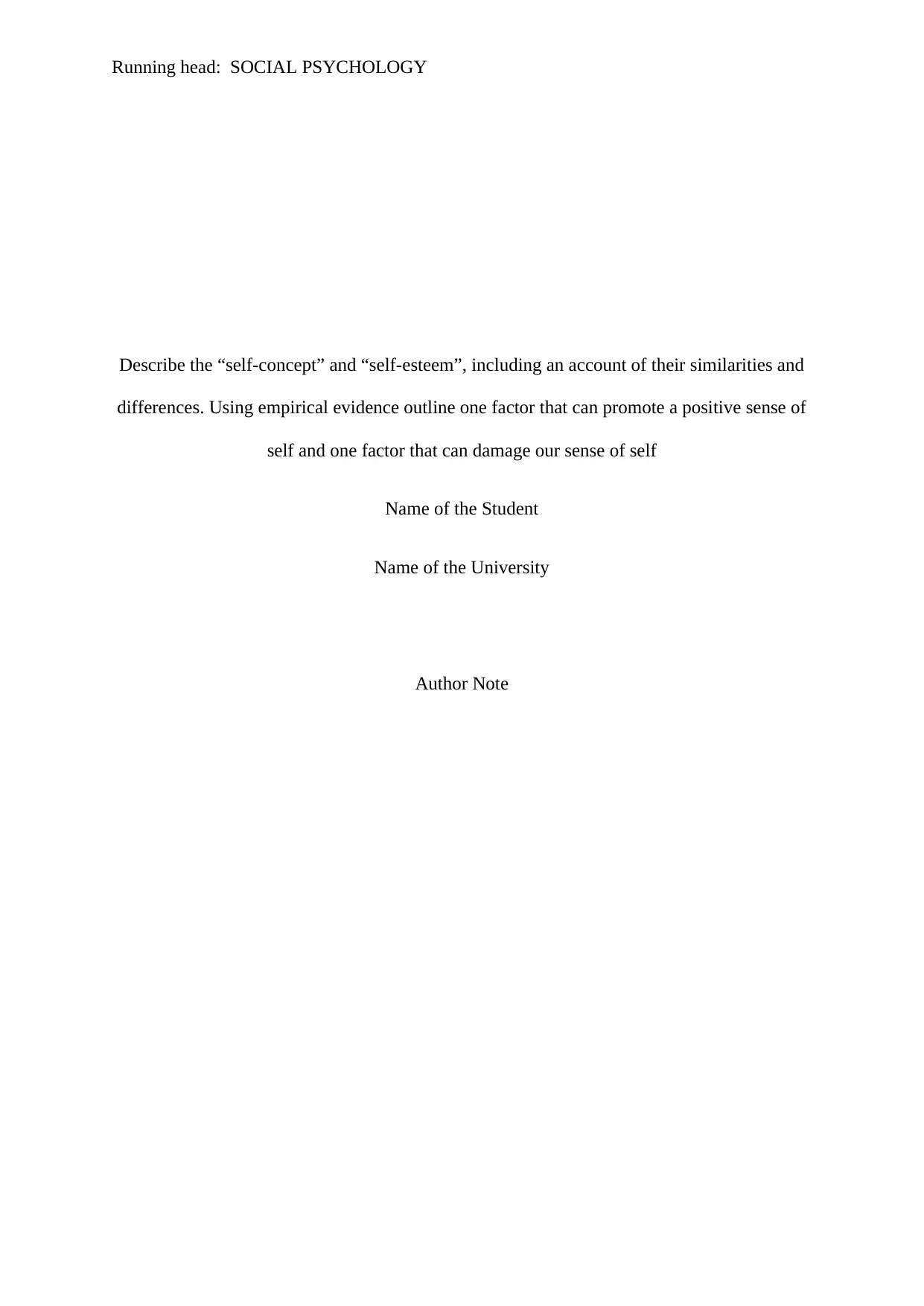
Running head: SOCIAL PSYCHOLOGY
Describe the “self-concept” and “self-esteem”, including an account of their similarities and
differences. Using empirical evidence outline one factor that can promote a positive sense of
self and one factor that can damage our sense of self
Name of the Student
Name of the University
Author Note
Describe the “self-concept” and “self-esteem”, including an account of their similarities and
differences. Using empirical evidence outline one factor that can promote a positive sense of
self and one factor that can damage our sense of self
Name of the Student
Name of the University
Author Note
Paraphrase This Document
Need a fresh take? Get an instant paraphrase of this document with our AI Paraphraser
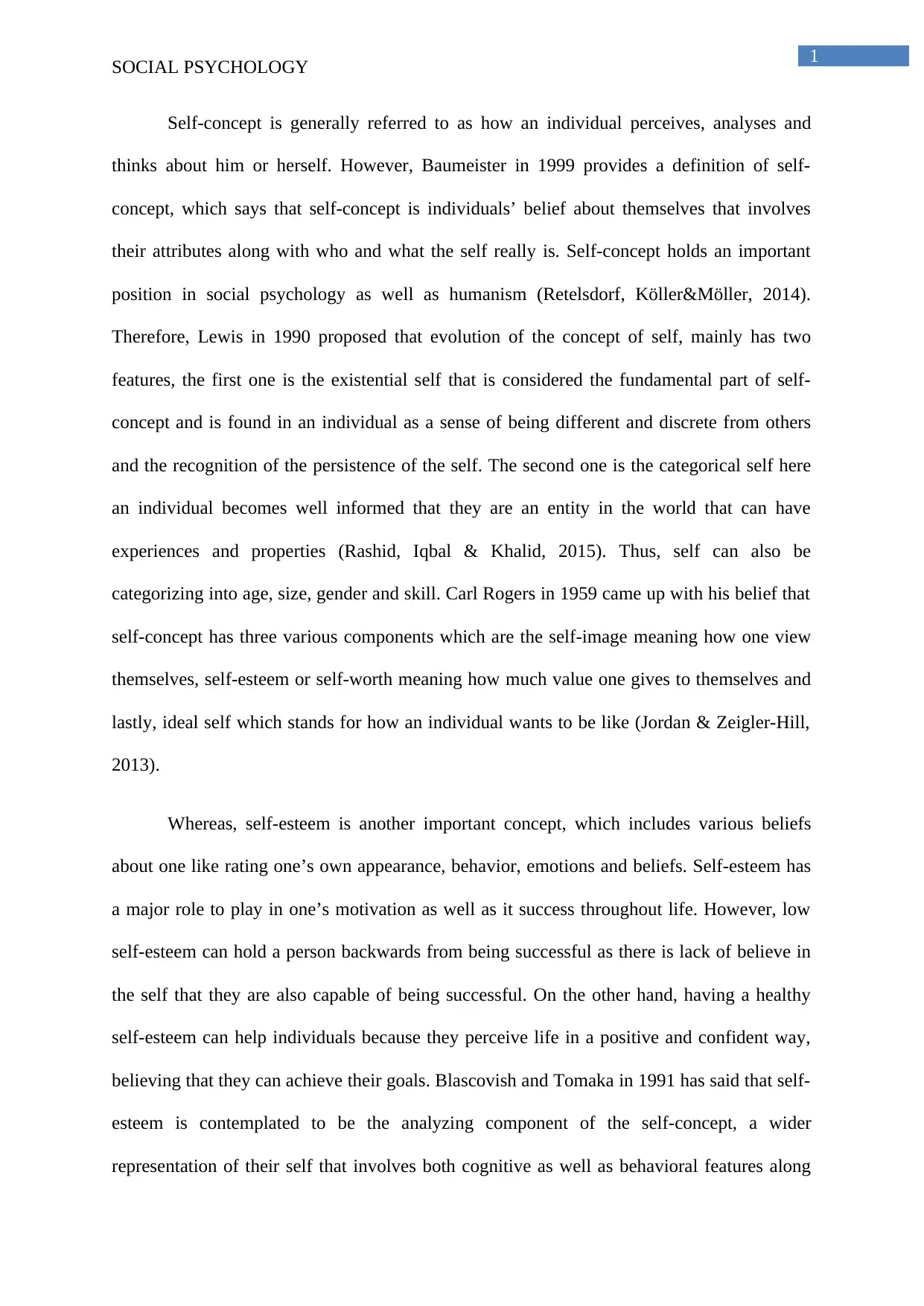
1
SOCIAL PSYCHOLOGY
Self-concept is generally referred to as how an individual perceives, analyses and
thinks about him or herself. However, Baumeister in 1999 provides a definition of self-
concept, which says that self-concept is individuals’ belief about themselves that involves
their attributes along with who and what the self really is. Self-concept holds an important
position in social psychology as well as humanism (Retelsdorf, Köller&Möller, 2014).
Therefore, Lewis in 1990 proposed that evolution of the concept of self, mainly has two
features, the first one is the existential self that is considered the fundamental part of self-
concept and is found in an individual as a sense of being different and discrete from others
and the recognition of the persistence of the self. The second one is the categorical self here
an individual becomes well informed that they are an entity in the world that can have
experiences and properties (Rashid, Iqbal & Khalid, 2015). Thus, self can also be
categorizing into age, size, gender and skill. Carl Rogers in 1959 came up with his belief that
self-concept has three various components which are the self-image meaning how one view
themselves, self-esteem or self-worth meaning how much value one gives to themselves and
lastly, ideal self which stands for how an individual wants to be like (Jordan & Zeigler-Hill,
2013).
Whereas, self-esteem is another important concept, which includes various beliefs
about one like rating one’s own appearance, behavior, emotions and beliefs. Self-esteem has
a major role to play in one’s motivation as well as it success throughout life. However, low
self-esteem can hold a person backwards from being successful as there is lack of believe in
the self that they are also capable of being successful. On the other hand, having a healthy
self-esteem can help individuals because they perceive life in a positive and confident way,
believing that they can achieve their goals. Blascovish and Tomaka in 1991 has said that self-
esteem is contemplated to be the analyzing component of the self-concept, a wider
representation of their self that involves both cognitive as well as behavioral features along
SOCIAL PSYCHOLOGY
Self-concept is generally referred to as how an individual perceives, analyses and
thinks about him or herself. However, Baumeister in 1999 provides a definition of self-
concept, which says that self-concept is individuals’ belief about themselves that involves
their attributes along with who and what the self really is. Self-concept holds an important
position in social psychology as well as humanism (Retelsdorf, Köller&Möller, 2014).
Therefore, Lewis in 1990 proposed that evolution of the concept of self, mainly has two
features, the first one is the existential self that is considered the fundamental part of self-
concept and is found in an individual as a sense of being different and discrete from others
and the recognition of the persistence of the self. The second one is the categorical self here
an individual becomes well informed that they are an entity in the world that can have
experiences and properties (Rashid, Iqbal & Khalid, 2015). Thus, self can also be
categorizing into age, size, gender and skill. Carl Rogers in 1959 came up with his belief that
self-concept has three various components which are the self-image meaning how one view
themselves, self-esteem or self-worth meaning how much value one gives to themselves and
lastly, ideal self which stands for how an individual wants to be like (Jordan & Zeigler-Hill,
2013).
Whereas, self-esteem is another important concept, which includes various beliefs
about one like rating one’s own appearance, behavior, emotions and beliefs. Self-esteem has
a major role to play in one’s motivation as well as it success throughout life. However, low
self-esteem can hold a person backwards from being successful as there is lack of believe in
the self that they are also capable of being successful. On the other hand, having a healthy
self-esteem can help individuals because they perceive life in a positive and confident way,
believing that they can achieve their goals. Blascovish and Tomaka in 1991 has said that self-
esteem is contemplated to be the analyzing component of the self-concept, a wider
representation of their self that involves both cognitive as well as behavioral features along
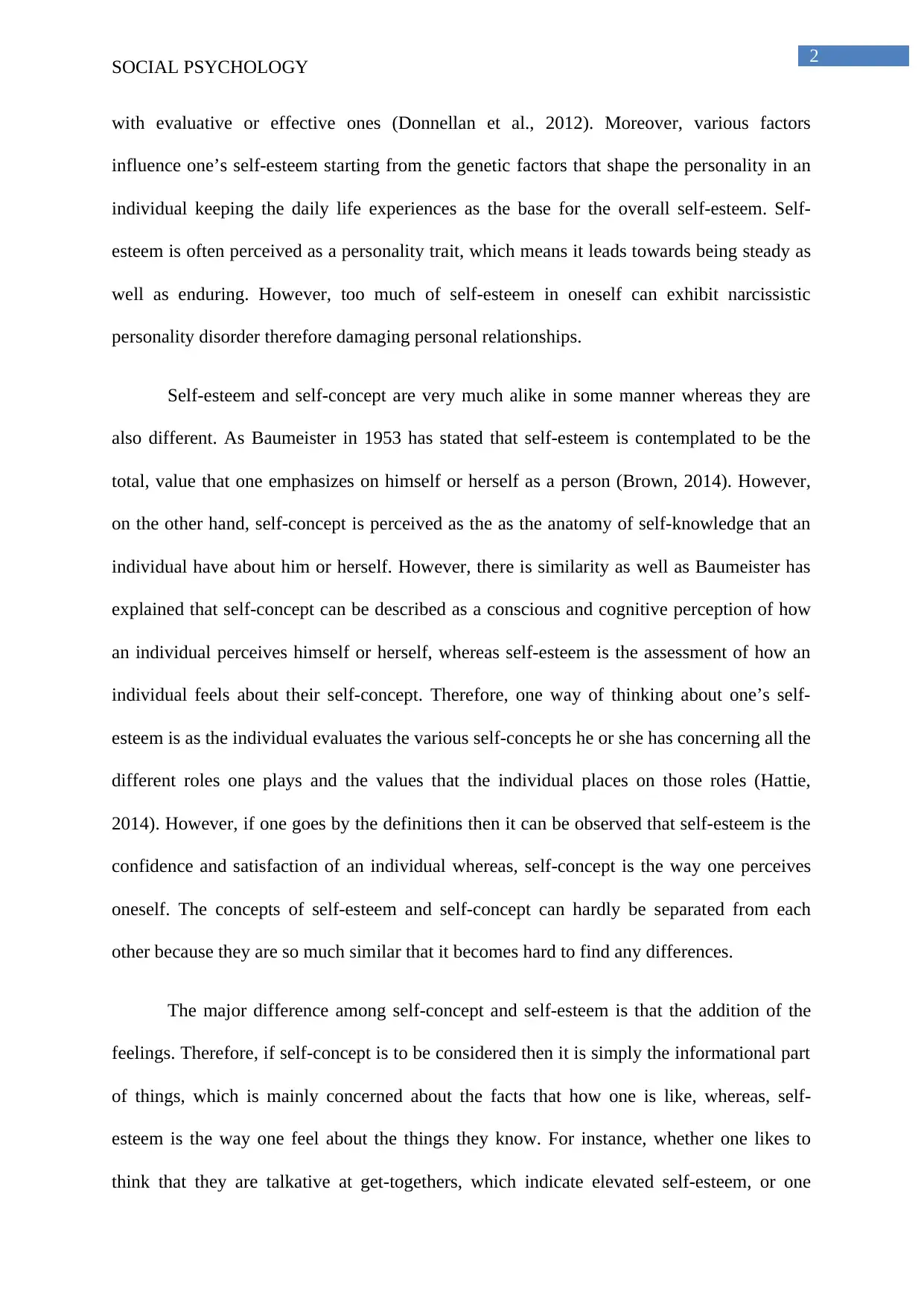
2
SOCIAL PSYCHOLOGY
with evaluative or effective ones (Donnellan et al., 2012). Moreover, various factors
influence one’s self-esteem starting from the genetic factors that shape the personality in an
individual keeping the daily life experiences as the base for the overall self-esteem. Self-
esteem is often perceived as a personality trait, which means it leads towards being steady as
well as enduring. However, too much of self-esteem in oneself can exhibit narcissistic
personality disorder therefore damaging personal relationships.
Self-esteem and self-concept are very much alike in some manner whereas they are
also different. As Baumeister in 1953 has stated that self-esteem is contemplated to be the
total, value that one emphasizes on himself or herself as a person (Brown, 2014). However,
on the other hand, self-concept is perceived as the as the anatomy of self-knowledge that an
individual have about him or herself. However, there is similarity as well as Baumeister has
explained that self-concept can be described as a conscious and cognitive perception of how
an individual perceives himself or herself, whereas self-esteem is the assessment of how an
individual feels about their self-concept. Therefore, one way of thinking about one’s self-
esteem is as the individual evaluates the various self-concepts he or she has concerning all the
different roles one plays and the values that the individual places on those roles (Hattie,
2014). However, if one goes by the definitions then it can be observed that self-esteem is the
confidence and satisfaction of an individual whereas, self-concept is the way one perceives
oneself. The concepts of self-esteem and self-concept can hardly be separated from each
other because they are so much similar that it becomes hard to find any differences.
The major difference among self-concept and self-esteem is that the addition of the
feelings. Therefore, if self-concept is to be considered then it is simply the informational part
of things, which is mainly concerned about the facts that how one is like, whereas, self-
esteem is the way one feel about the things they know. For instance, whether one likes to
think that they are talkative at get-togethers, which indicate elevated self-esteem, or one
SOCIAL PSYCHOLOGY
with evaluative or effective ones (Donnellan et al., 2012). Moreover, various factors
influence one’s self-esteem starting from the genetic factors that shape the personality in an
individual keeping the daily life experiences as the base for the overall self-esteem. Self-
esteem is often perceived as a personality trait, which means it leads towards being steady as
well as enduring. However, too much of self-esteem in oneself can exhibit narcissistic
personality disorder therefore damaging personal relationships.
Self-esteem and self-concept are very much alike in some manner whereas they are
also different. As Baumeister in 1953 has stated that self-esteem is contemplated to be the
total, value that one emphasizes on himself or herself as a person (Brown, 2014). However,
on the other hand, self-concept is perceived as the as the anatomy of self-knowledge that an
individual have about him or herself. However, there is similarity as well as Baumeister has
explained that self-concept can be described as a conscious and cognitive perception of how
an individual perceives himself or herself, whereas self-esteem is the assessment of how an
individual feels about their self-concept. Therefore, one way of thinking about one’s self-
esteem is as the individual evaluates the various self-concepts he or she has concerning all the
different roles one plays and the values that the individual places on those roles (Hattie,
2014). However, if one goes by the definitions then it can be observed that self-esteem is the
confidence and satisfaction of an individual whereas, self-concept is the way one perceives
oneself. The concepts of self-esteem and self-concept can hardly be separated from each
other because they are so much similar that it becomes hard to find any differences.
The major difference among self-concept and self-esteem is that the addition of the
feelings. Therefore, if self-concept is to be considered then it is simply the informational part
of things, which is mainly concerned about the facts that how one is like, whereas, self-
esteem is the way one feel about the things they know. For instance, whether one likes to
think that they are talkative at get-togethers, which indicate elevated self-esteem, or one
⊘ This is a preview!⊘
Do you want full access?
Subscribe today to unlock all pages.

Trusted by 1+ million students worldwide
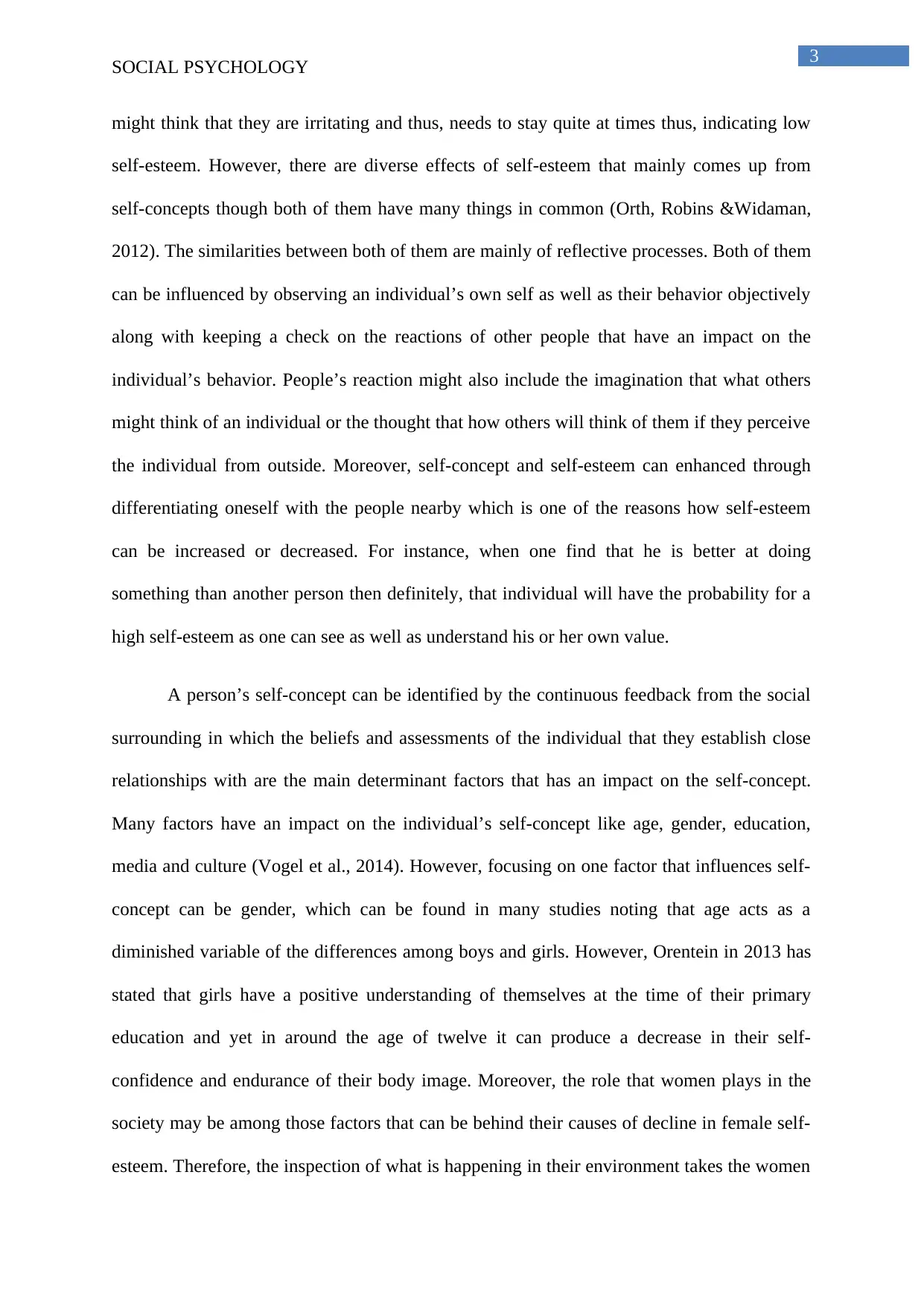
3
SOCIAL PSYCHOLOGY
might think that they are irritating and thus, needs to stay quite at times thus, indicating low
self-esteem. However, there are diverse effects of self-esteem that mainly comes up from
self-concepts though both of them have many things in common (Orth, Robins &Widaman,
2012). The similarities between both of them are mainly of reflective processes. Both of them
can be influenced by observing an individual’s own self as well as their behavior objectively
along with keeping a check on the reactions of other people that have an impact on the
individual’s behavior. People’s reaction might also include the imagination that what others
might think of an individual or the thought that how others will think of them if they perceive
the individual from outside. Moreover, self-concept and self-esteem can enhanced through
differentiating oneself with the people nearby which is one of the reasons how self-esteem
can be increased or decreased. For instance, when one find that he is better at doing
something than another person then definitely, that individual will have the probability for a
high self-esteem as one can see as well as understand his or her own value.
A person’s self-concept can be identified by the continuous feedback from the social
surrounding in which the beliefs and assessments of the individual that they establish close
relationships with are the main determinant factors that has an impact on the self-concept.
Many factors have an impact on the individual’s self-concept like age, gender, education,
media and culture (Vogel et al., 2014). However, focusing on one factor that influences self-
concept can be gender, which can be found in many studies noting that age acts as a
diminished variable of the differences among boys and girls. However, Orentein in 2013 has
stated that girls have a positive understanding of themselves at the time of their primary
education and yet in around the age of twelve it can produce a decrease in their self-
confidence and endurance of their body image. Moreover, the role that women plays in the
society may be among those factors that can be behind their causes of decline in female self-
esteem. Therefore, the inspection of what is happening in their environment takes the women
SOCIAL PSYCHOLOGY
might think that they are irritating and thus, needs to stay quite at times thus, indicating low
self-esteem. However, there are diverse effects of self-esteem that mainly comes up from
self-concepts though both of them have many things in common (Orth, Robins &Widaman,
2012). The similarities between both of them are mainly of reflective processes. Both of them
can be influenced by observing an individual’s own self as well as their behavior objectively
along with keeping a check on the reactions of other people that have an impact on the
individual’s behavior. People’s reaction might also include the imagination that what others
might think of an individual or the thought that how others will think of them if they perceive
the individual from outside. Moreover, self-concept and self-esteem can enhanced through
differentiating oneself with the people nearby which is one of the reasons how self-esteem
can be increased or decreased. For instance, when one find that he is better at doing
something than another person then definitely, that individual will have the probability for a
high self-esteem as one can see as well as understand his or her own value.
A person’s self-concept can be identified by the continuous feedback from the social
surrounding in which the beliefs and assessments of the individual that they establish close
relationships with are the main determinant factors that has an impact on the self-concept.
Many factors have an impact on the individual’s self-concept like age, gender, education,
media and culture (Vogel et al., 2014). However, focusing on one factor that influences self-
concept can be gender, which can be found in many studies noting that age acts as a
diminished variable of the differences among boys and girls. However, Orentein in 2013 has
stated that girls have a positive understanding of themselves at the time of their primary
education and yet in around the age of twelve it can produce a decrease in their self-
confidence and endurance of their body image. Moreover, the role that women plays in the
society may be among those factors that can be behind their causes of decline in female self-
esteem. Therefore, the inspection of what is happening in their environment takes the women
Paraphrase This Document
Need a fresh take? Get an instant paraphrase of this document with our AI Paraphraser
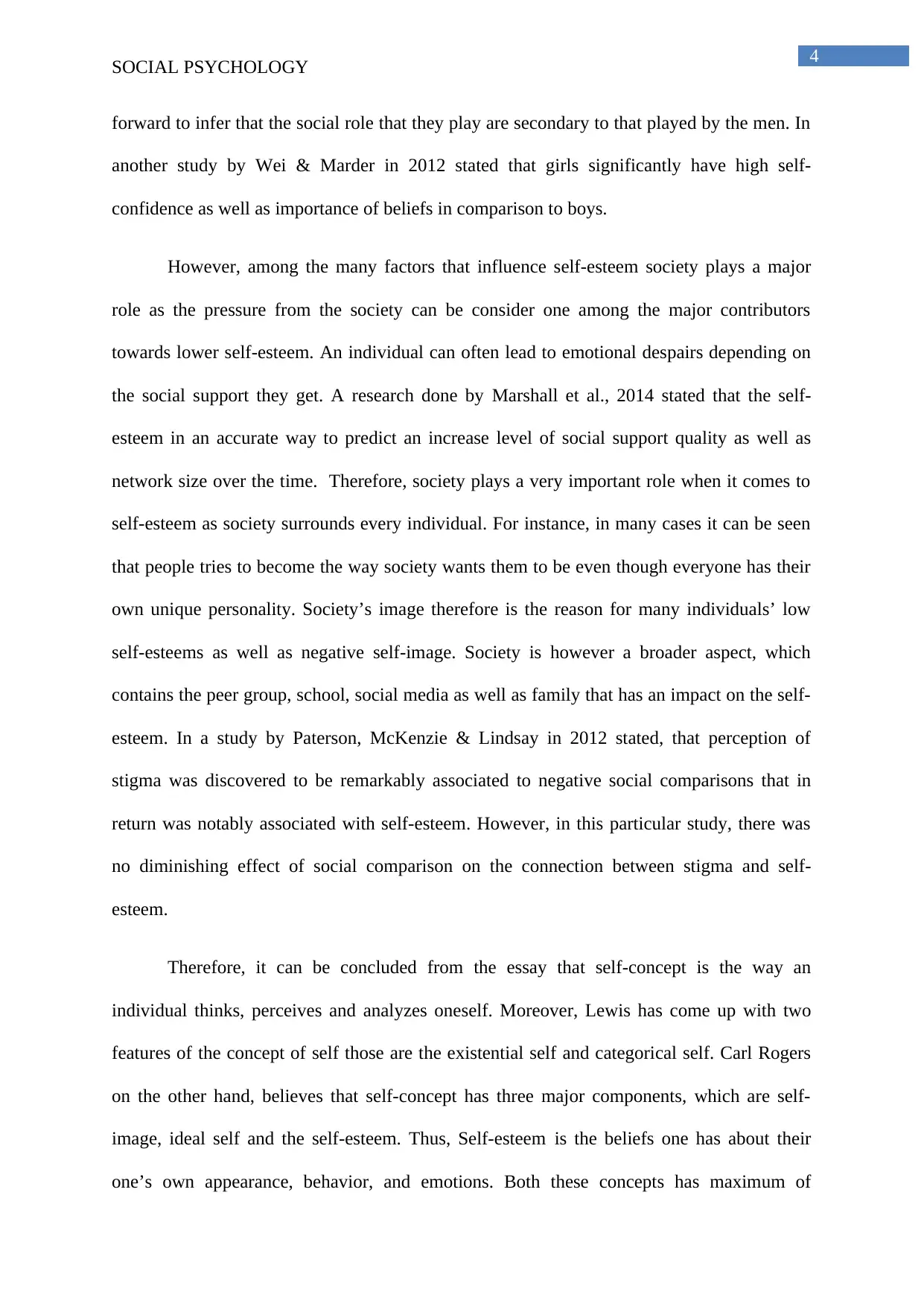
4
SOCIAL PSYCHOLOGY
forward to infer that the social role that they play are secondary to that played by the men. In
another study by Wei & Marder in 2012 stated that girls significantly have high self-
confidence as well as importance of beliefs in comparison to boys.
However, among the many factors that influence self-esteem society plays a major
role as the pressure from the society can be consider one among the major contributors
towards lower self-esteem. An individual can often lead to emotional despairs depending on
the social support they get. A research done by Marshall et al., 2014 stated that the self-
esteem in an accurate way to predict an increase level of social support quality as well as
network size over the time. Therefore, society plays a very important role when it comes to
self-esteem as society surrounds every individual. For instance, in many cases it can be seen
that people tries to become the way society wants them to be even though everyone has their
own unique personality. Society’s image therefore is the reason for many individuals’ low
self-esteems as well as negative self-image. Society is however a broader aspect, which
contains the peer group, school, social media as well as family that has an impact on the self-
esteem. In a study by Paterson, McKenzie & Lindsay in 2012 stated, that perception of
stigma was discovered to be remarkably associated to negative social comparisons that in
return was notably associated with self-esteem. However, in this particular study, there was
no diminishing effect of social comparison on the connection between stigma and self-
esteem.
Therefore, it can be concluded from the essay that self-concept is the way an
individual thinks, perceives and analyzes oneself. Moreover, Lewis has come up with two
features of the concept of self those are the existential self and categorical self. Carl Rogers
on the other hand, believes that self-concept has three major components, which are self-
image, ideal self and the self-esteem. Thus, Self-esteem is the beliefs one has about their
one’s own appearance, behavior, and emotions. Both these concepts has maximum of
SOCIAL PSYCHOLOGY
forward to infer that the social role that they play are secondary to that played by the men. In
another study by Wei & Marder in 2012 stated that girls significantly have high self-
confidence as well as importance of beliefs in comparison to boys.
However, among the many factors that influence self-esteem society plays a major
role as the pressure from the society can be consider one among the major contributors
towards lower self-esteem. An individual can often lead to emotional despairs depending on
the social support they get. A research done by Marshall et al., 2014 stated that the self-
esteem in an accurate way to predict an increase level of social support quality as well as
network size over the time. Therefore, society plays a very important role when it comes to
self-esteem as society surrounds every individual. For instance, in many cases it can be seen
that people tries to become the way society wants them to be even though everyone has their
own unique personality. Society’s image therefore is the reason for many individuals’ low
self-esteems as well as negative self-image. Society is however a broader aspect, which
contains the peer group, school, social media as well as family that has an impact on the self-
esteem. In a study by Paterson, McKenzie & Lindsay in 2012 stated, that perception of
stigma was discovered to be remarkably associated to negative social comparisons that in
return was notably associated with self-esteem. However, in this particular study, there was
no diminishing effect of social comparison on the connection between stigma and self-
esteem.
Therefore, it can be concluded from the essay that self-concept is the way an
individual thinks, perceives and analyzes oneself. Moreover, Lewis has come up with two
features of the concept of self those are the existential self and categorical self. Carl Rogers
on the other hand, believes that self-concept has three major components, which are self-
image, ideal self and the self-esteem. Thus, Self-esteem is the beliefs one has about their
one’s own appearance, behavior, and emotions. Both these concepts has maximum of
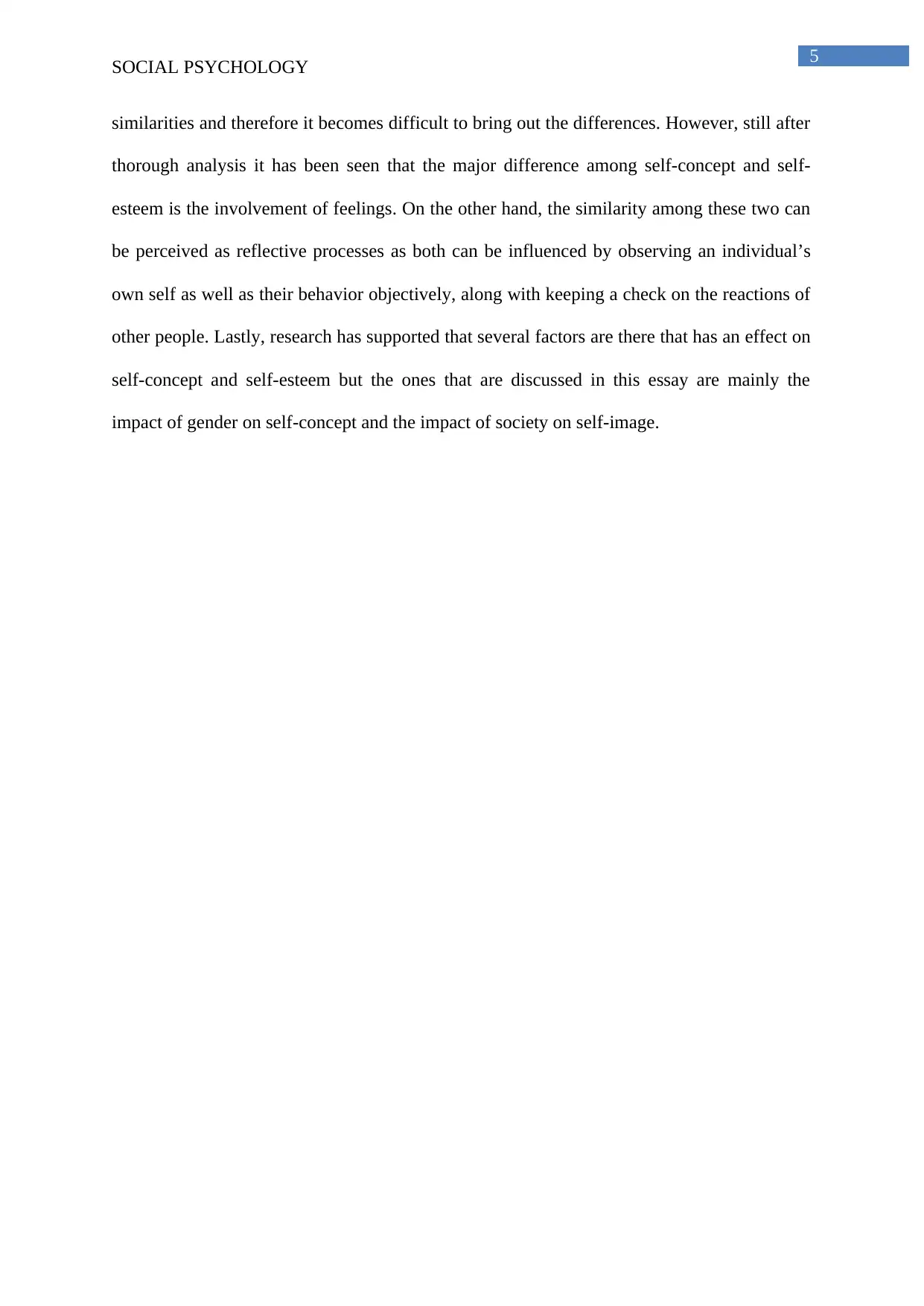
5
SOCIAL PSYCHOLOGY
similarities and therefore it becomes difficult to bring out the differences. However, still after
thorough analysis it has been seen that the major difference among self-concept and self-
esteem is the involvement of feelings. On the other hand, the similarity among these two can
be perceived as reflective processes as both can be influenced by observing an individual’s
own self as well as their behavior objectively, along with keeping a check on the reactions of
other people. Lastly, research has supported that several factors are there that has an effect on
self-concept and self-esteem but the ones that are discussed in this essay are mainly the
impact of gender on self-concept and the impact of society on self-image.
SOCIAL PSYCHOLOGY
similarities and therefore it becomes difficult to bring out the differences. However, still after
thorough analysis it has been seen that the major difference among self-concept and self-
esteem is the involvement of feelings. On the other hand, the similarity among these two can
be perceived as reflective processes as both can be influenced by observing an individual’s
own self as well as their behavior objectively, along with keeping a check on the reactions of
other people. Lastly, research has supported that several factors are there that has an effect on
self-concept and self-esteem but the ones that are discussed in this essay are mainly the
impact of gender on self-concept and the impact of society on self-image.
⊘ This is a preview!⊘
Do you want full access?
Subscribe today to unlock all pages.

Trusted by 1+ million students worldwide
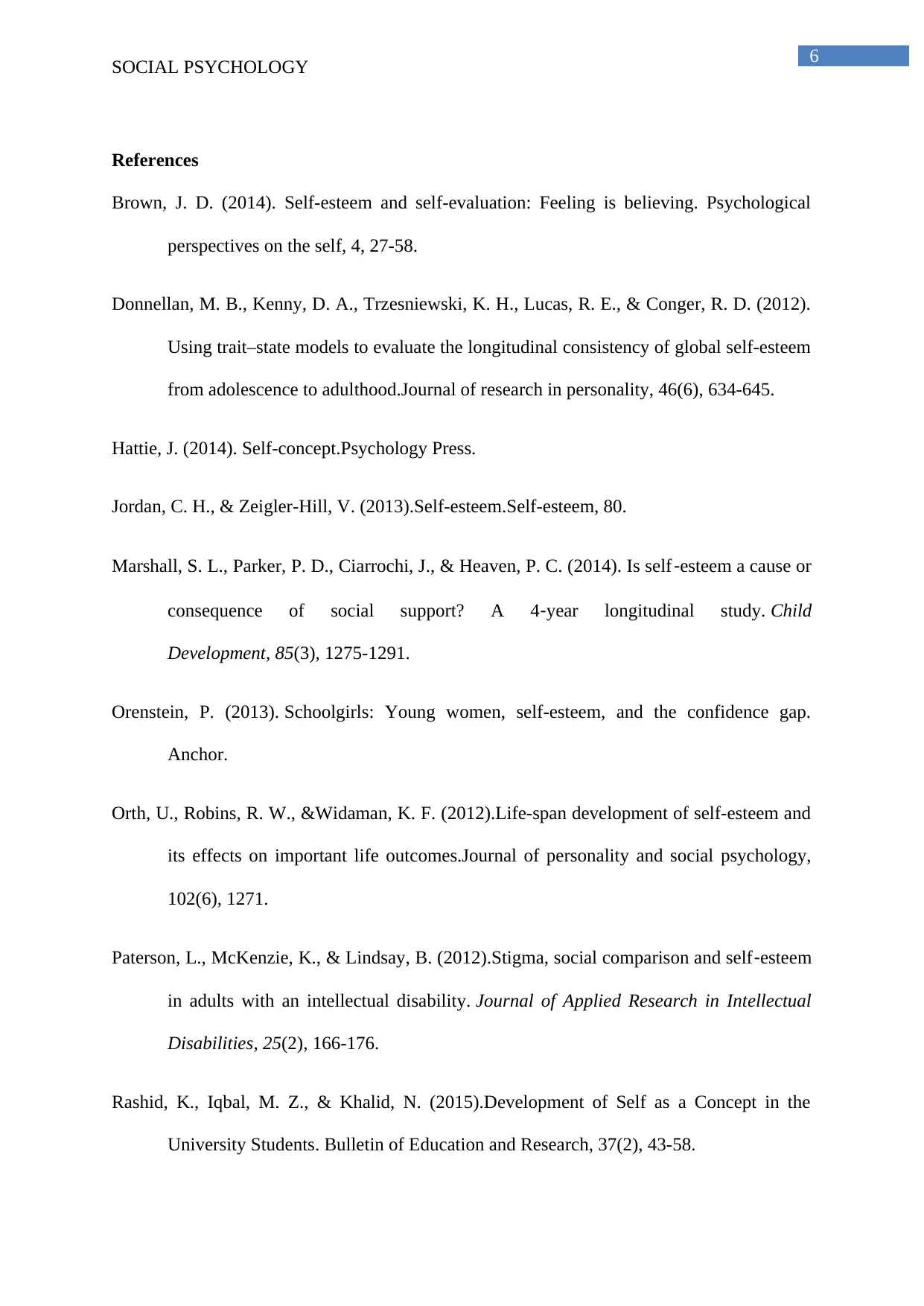
6
SOCIAL PSYCHOLOGY
References
Brown, J. D. (2014). Self-esteem and self-evaluation: Feeling is believing. Psychological
perspectives on the self, 4, 27-58.
Donnellan, M. B., Kenny, D. A., Trzesniewski, K. H., Lucas, R. E., & Conger, R. D. (2012).
Using trait–state models to evaluate the longitudinal consistency of global self-esteem
from adolescence to adulthood.Journal of research in personality, 46(6), 634-645.
Hattie, J. (2014). Self-concept.Psychology Press.
Jordan, C. H., & Zeigler-Hill, V. (2013).Self-esteem.Self-esteem, 80.
Marshall, S. L., Parker, P. D., Ciarrochi, J., & Heaven, P. C. (2014). Is self‐esteem a cause or
consequence of social support? A 4‐year longitudinal study. Child
Development, 85(3), 1275-1291.
Orenstein, P. (2013). Schoolgirls: Young women, self-esteem, and the confidence gap.
Anchor.
Orth, U., Robins, R. W., &Widaman, K. F. (2012).Life-span development of self-esteem and
its effects on important life outcomes.Journal of personality and social psychology,
102(6), 1271.
Paterson, L., McKenzie, K., & Lindsay, B. (2012).Stigma, social comparison and self‐esteem
in adults with an intellectual disability. Journal of Applied Research in Intellectual
Disabilities, 25(2), 166-176.
Rashid, K., Iqbal, M. Z., & Khalid, N. (2015).Development of Self as a Concept in the
University Students. Bulletin of Education and Research, 37(2), 43-58.
SOCIAL PSYCHOLOGY
References
Brown, J. D. (2014). Self-esteem and self-evaluation: Feeling is believing. Psychological
perspectives on the self, 4, 27-58.
Donnellan, M. B., Kenny, D. A., Trzesniewski, K. H., Lucas, R. E., & Conger, R. D. (2012).
Using trait–state models to evaluate the longitudinal consistency of global self-esteem
from adolescence to adulthood.Journal of research in personality, 46(6), 634-645.
Hattie, J. (2014). Self-concept.Psychology Press.
Jordan, C. H., & Zeigler-Hill, V. (2013).Self-esteem.Self-esteem, 80.
Marshall, S. L., Parker, P. D., Ciarrochi, J., & Heaven, P. C. (2014). Is self‐esteem a cause or
consequence of social support? A 4‐year longitudinal study. Child
Development, 85(3), 1275-1291.
Orenstein, P. (2013). Schoolgirls: Young women, self-esteem, and the confidence gap.
Anchor.
Orth, U., Robins, R. W., &Widaman, K. F. (2012).Life-span development of self-esteem and
its effects on important life outcomes.Journal of personality and social psychology,
102(6), 1271.
Paterson, L., McKenzie, K., & Lindsay, B. (2012).Stigma, social comparison and self‐esteem
in adults with an intellectual disability. Journal of Applied Research in Intellectual
Disabilities, 25(2), 166-176.
Rashid, K., Iqbal, M. Z., & Khalid, N. (2015).Development of Self as a Concept in the
University Students. Bulletin of Education and Research, 37(2), 43-58.
Paraphrase This Document
Need a fresh take? Get an instant paraphrase of this document with our AI Paraphraser
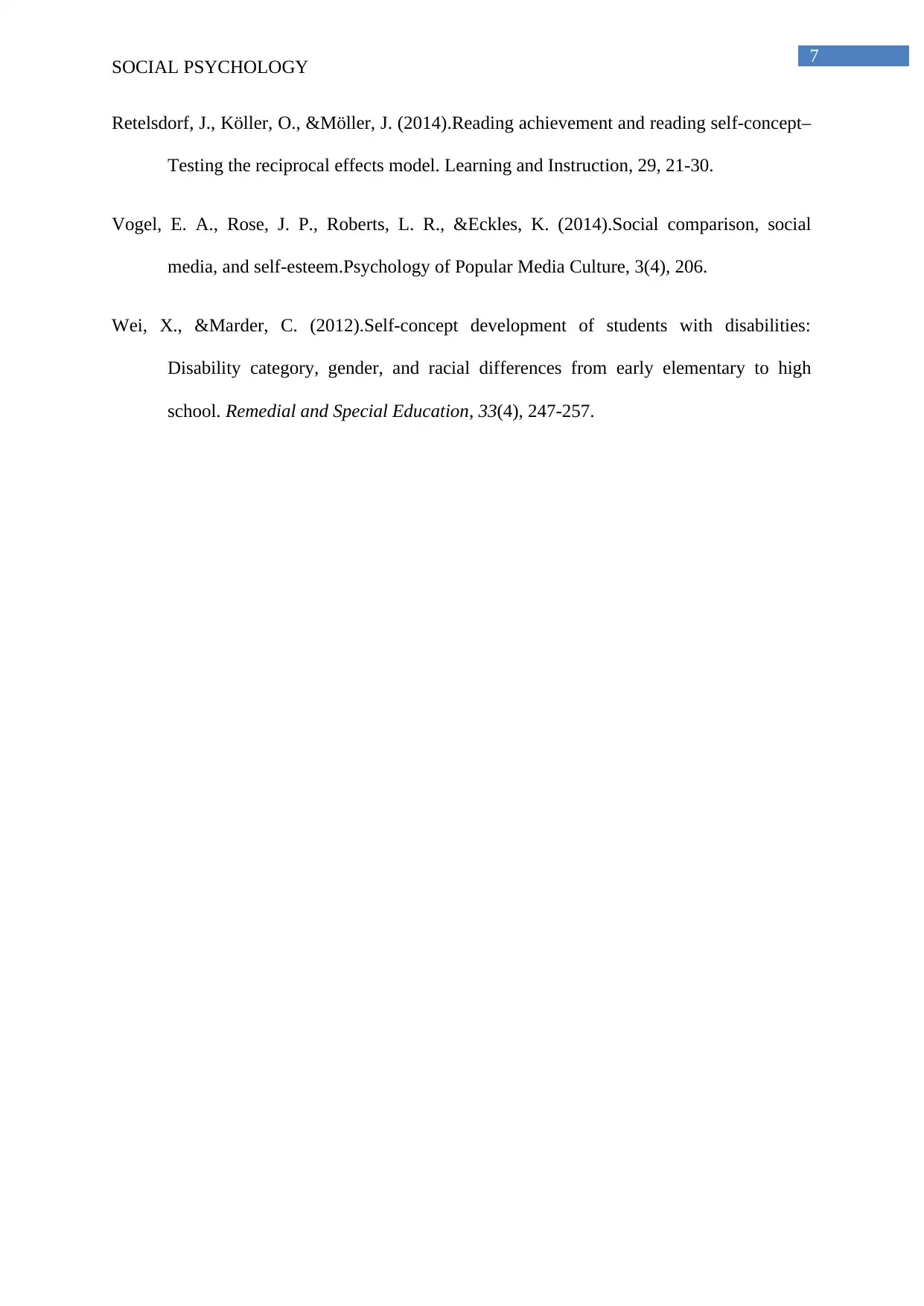
7
SOCIAL PSYCHOLOGY
Retelsdorf, J., Köller, O., &Möller, J. (2014).Reading achievement and reading self-concept–
Testing the reciprocal effects model. Learning and Instruction, 29, 21-30.
Vogel, E. A., Rose, J. P., Roberts, L. R., &Eckles, K. (2014).Social comparison, social
media, and self-esteem.Psychology of Popular Media Culture, 3(4), 206.
Wei, X., &Marder, C. (2012).Self-concept development of students with disabilities:
Disability category, gender, and racial differences from early elementary to high
school. Remedial and Special Education, 33(4), 247-257.
SOCIAL PSYCHOLOGY
Retelsdorf, J., Köller, O., &Möller, J. (2014).Reading achievement and reading self-concept–
Testing the reciprocal effects model. Learning and Instruction, 29, 21-30.
Vogel, E. A., Rose, J. P., Roberts, L. R., &Eckles, K. (2014).Social comparison, social
media, and self-esteem.Psychology of Popular Media Culture, 3(4), 206.
Wei, X., &Marder, C. (2012).Self-concept development of students with disabilities:
Disability category, gender, and racial differences from early elementary to high
school. Remedial and Special Education, 33(4), 247-257.
1 out of 8
Related Documents
Your All-in-One AI-Powered Toolkit for Academic Success.
+13062052269
info@desklib.com
Available 24*7 on WhatsApp / Email
![[object Object]](/_next/static/media/star-bottom.7253800d.svg)
Unlock your academic potential
Copyright © 2020–2025 A2Z Services. All Rights Reserved. Developed and managed by ZUCOL.





